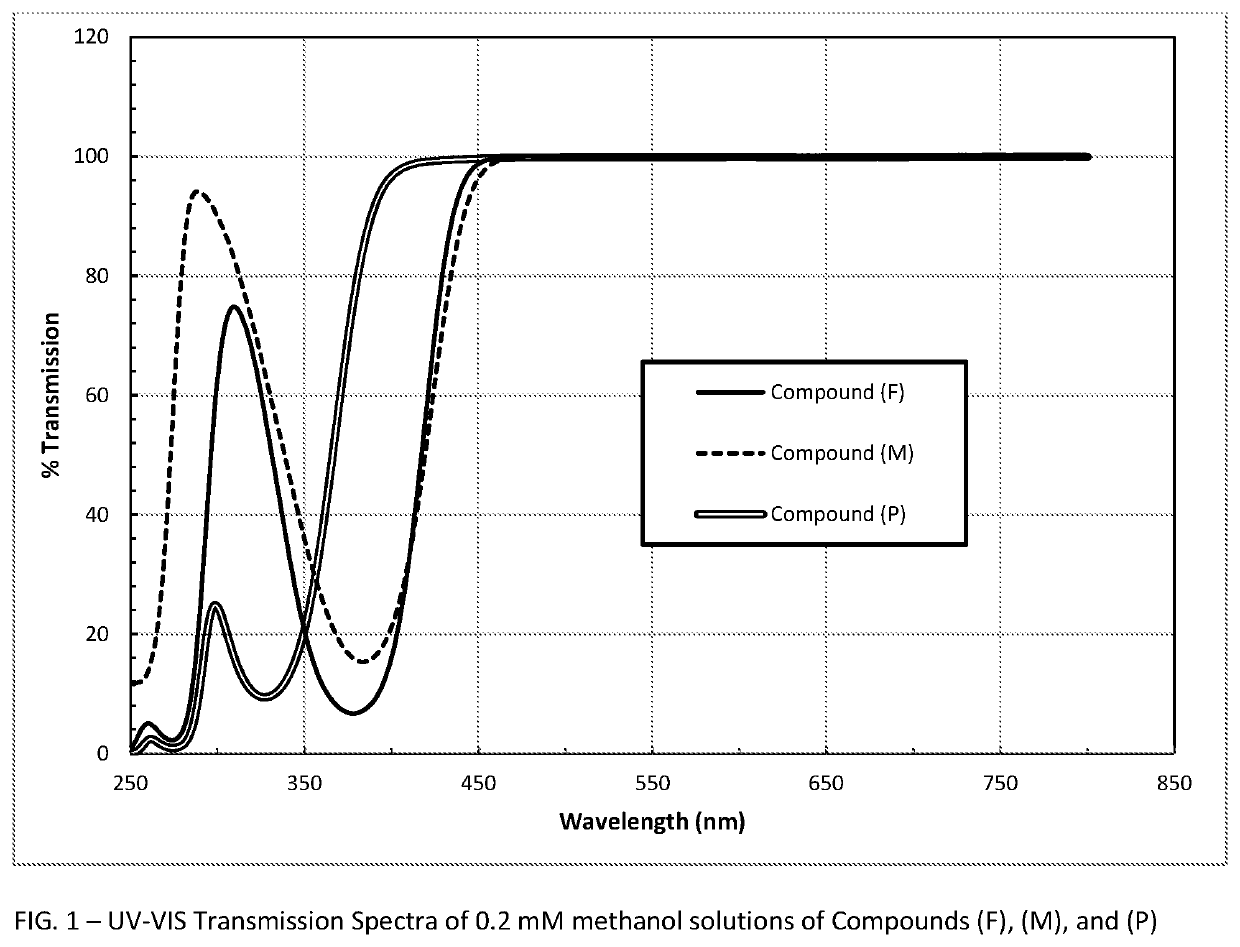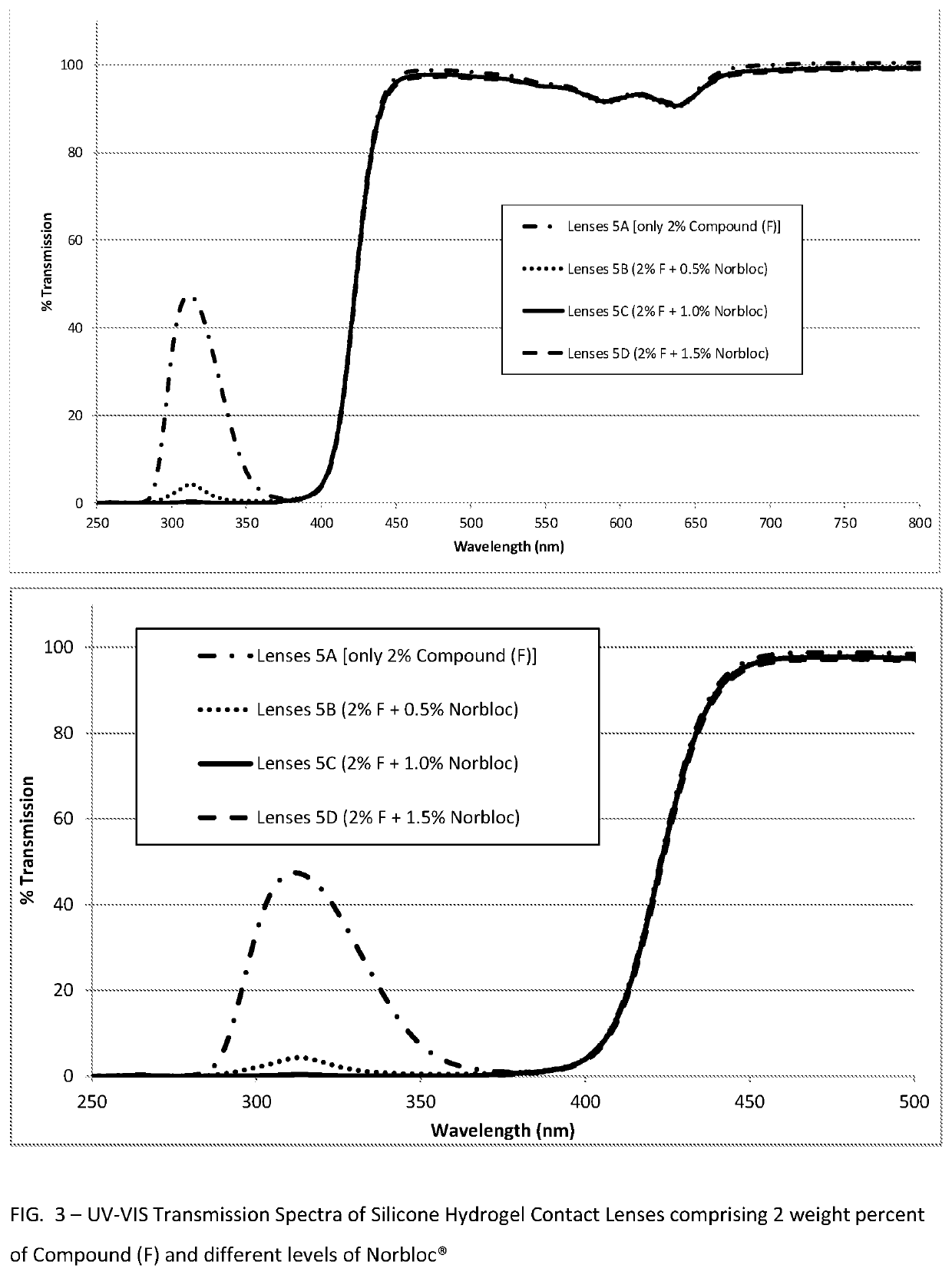Polymerizable absorbers of UV and high energy visible light
a technology of visible light and absorbers, applied in the field of ultraviolet light and high energy visible light absorbers, can solve the problems of ineffective protection of the back of the eye, 400 nm, cell damage, etc., and achieve the effect of being readily covalently integrated into the final produ
- Summary
- Abstract
- Description
- Claims
- Application Information
AI Technical Summary
Benefits of technology
Problems solved by technology
Method used
Image
Examples
example 1
of Compound (F) in Scheme 2
[0322]
Synthesis of 4-acetyl-2,6-dimethoxyphenyl acetate (B)
[0323]4-Hydroxy-3,5-dimethoxyacetophenone (5.0 g, 26.0 mmol) and triethyl amine (5.78 grams, 57.20 mmol) were dissolved in DCM (50 mL) under nitrogen and cooled to 0° C. (ice-bath). Acetyl chloride (2.2 grams, 28.00 mmol) was added drop wise and stirred the reaction mixture at same temperature for 30 min followed by r.t. for 6 hours. Upon completion, water (50 mL) was added and extracted with DCM (3×25 mL), the combined organic extracts were washed with water (50 mL), dried over Na2SO4, filtered, the solvent was removed under reduce pressure and the residue was recrystallized from DCM / n-hexanes to afford a white solid (95% yield). 1H-NMR (CDCl3, 500 MHz): δ 2.36 (s, 3H), 2.60 (s, 3H), 3.89 (s, 6H), 7.23 (s, 2H).
Synthesis of 4-acetyl-2,6-dimethoxy-3-nitrophenyl acetate (C)
[0324]4-acetyl-2,6-dimethoxyphenyl acetate (4.22 grams, 17.80 mmol) was dissolved in acetic anhydride (50 mL) with gentle heating...
example 2
of Compound (M) in Scheme 3
[0328]
1-(5-Chloro-2-nitrophenyl)propan-1-one (H)
[0329]Nitric acid (fuming, 200 mL) was cooled to −5° C. in an ice-salt bath and 3-chloropropiophenone (40.0 grams) was added portion-wise with stirring at a rate that maintained the temperature between −5° C. and −3° C. (using an ice-salt bath). After the addition was completed, the reaction mixture was stirred for another 30 minutes at −3° C. and then poured into ice-water (1000.0 grams). A yellow precipitate was collected by filtration and washed with aqueous NaHCO3 and water thoroughly. Recrystallization from EtOH (300 mL) afforded (H) as light-yellow needles (95% yield). 1H-NMR (CDCl3, 500 MHz): δ 1.24 (t, 3H, J=7.0 Hz), 2.78 (m, 2H), 7.32 (s, 1H), 7.55 (m, 1H), 8.08 (d, 1H, J=9.0 Hz).
2-(5-Chloro-2-nitrophenyl)-2-ethyl-1,3-dioxolane (I)
[0330]1-(5-Chloro-2-nitrophenyl)propan-1-one (6.5 grams, 30.4 mmol) and anhydrous 1,2-ethylene glycol (4.2 grams, 67.5 mmol) were dissolved in anhydrous toluene (200 mL), a...
example 3
of Compound (P) in Scheme 4
[0335]
2-(5-Acetyl-2-nitrophenoxy)ethyl methacrylate (0)
[0336]3-Hydroxy-4-nitroacetophenone (2.5 grams, 13.8 mmol) was dissolved in DMSO (25 mL), and then K2CO3 (2.98 g, 21.6 mmol) was added followed by 2-chloroethyl methacrylate (3.04 grams, 20.5 mmol). The reaction mixture was heated at 85° C. for 24 hours. Water was added and extracted with DCM (3×25 mL). The combined organic extracts were washed with brine (50 mL), dried over Na2SO4, filtered, and concentrated under reduce pressure. The crude product was purified by recrystallization from Et0H (30 mL) to afford (0) as a light yellow solid (90% yield). 1H-NMR (CDCl3, 500 MHz): δ 1.95 (s, 3H), 2.61 (s, 3H), 4.44 (m, 2H), 4.57 (m, 2H), 5.61 (s, 1H), 6.15 (s, 1H), 7.17 (d, 2H J=9.0 Hz), 8.15 (dd, 1H, J=1.5, 9.0 Hz), 8.41 (d, 1H, J=1.5 Hz).
2-(5-Acetyl-2-aminophenoxy)ethyl methacrylate (P)
[0337]2-(5-Acetyl-2-nitrophenoxy)ethyl methacrylate (0.8 grams, 2.73 mmol) was dissolved in Et0H (25 mL, containing 300 pp...
PUM
| Property | Measurement | Unit |
|---|---|---|
| wavelengths | aaaaa | aaaaa |
| wavelengths | aaaaa | aaaaa |
| wavelength | aaaaa | aaaaa |
Abstract
Description
Claims
Application Information
 Login to View More
Login to View More - R&D
- Intellectual Property
- Life Sciences
- Materials
- Tech Scout
- Unparalleled Data Quality
- Higher Quality Content
- 60% Fewer Hallucinations
Browse by: Latest US Patents, China's latest patents, Technical Efficacy Thesaurus, Application Domain, Technology Topic, Popular Technical Reports.
© 2025 PatSnap. All rights reserved.Legal|Privacy policy|Modern Slavery Act Transparency Statement|Sitemap|About US| Contact US: help@patsnap.com



